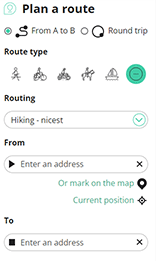Source: GroeneHartstocht
In 1176 the name "Reste" appears in a written source. This is a letter from Bishop Godefridus of Utrecht about five houses on De Reste. In the Middle Ages (500-1500) farmers settled in the vicinity of the Reest for the first time in history, so it is not that remarkable. Before the Middle Ages and in antiquity, there was hardly any habitation on the flanks of the wet and swampy peatland on both sides of the Reest. The peat stream originated in the raised bogs of Slagharen and Lutten and drained the water towards the Zwarte Water. This situation has lasted for centuries.
De Reest also has other names: the Reste, Resten, Reeste, Reesterstroom, Rijeste, de Riest. The meaning of the word Reest is associated with concepts such as movement and flow, but that is not entirely clear.
In the 16th century, skippers sailed as far as possible up the Reest to transport goods to the town of Coevorden in Drenthe. This was only possible at high tide, so not in the summer period. When the Ommerschans was reinforced around 1670, materials were transported across the Reest, among other places. In the 18th and 19th centuries, street waste (street rack) and compost (including from Kampen) were brought with punts via the Reest to higher mining grounds. The Reest was navigable until 1869. At that time, a railway bridge over the Reest was built at Meppel and transport by water was no longer possible.
The Reest now flows as far as Meppel, but that was still different in the 19th century. The stream meandered further towards Zwartsluis and was named Zede or Sethe after Meppel. In 1860 the Meppelerdiep was dug and the lower reaches of the Reest disappeared.
Until the Middle Ages, the valley was a vast, almost inaccessible peatland with swamp forests here and there. Farmers and monks of the monastery of Dickninge mined parts into fields or hayfields. The farms are mainly founded on the drier sand heads, also called horsts. Old farm names such as Schiphorst, Lindenhorst, Havixhorst and Hoge Linthorst still bear witness to this.
On the border of Overijssel and Drenthe lies the Reestdal. A centuries-old small-scale landscape with forest, heathland, hay meadows and old farms with an interesting history. The Reest still winds through the landscape largely in its original form. Visit the Reestdal, be surprised by the variation in the landscape and take a step back in time.
An area with a rich history
Flowering hay meadows, waving grain with blue cornflowers, forest, heather and authentic farms. In the Reestdal you can enjoy a beautiful view, farm life, a field of dotter flowers or the soothing sound of the rippling water of the Reest. The stream valley evokes a feeling of living in different times. The area has many historical elements, such as coppice forests, hedgerows, grain fields and old church paths. These elements are maintained and managed as they have been for centuries. Partly because of this form of management, the Reestdal has become what it is today.
Typical for the Reestdal is the small scale. On the small fields you will find cereals, cornflowers and chamomile and on the slightly higher grounds poppies shine. And in between, the Reest squirms and rippling. Are you near the village of Oud Avereest? Then walk along the Reest and enjoy the hayfields and fields. In spring, enjoy the buzzing, fluttering and color on the beautiful hayfields just along the river De Reest.
The rippling Reest
With a length of 37 kilometers, the Reest has marked the border between the provinces of Overijssel and Drenthe for centuries. In the past 800 years, the stream valley has not changed in general. Where in the Netherlands numerous rivers and streams have been straightened, the Reest is still a friendly winding river. Thanks to the annual floods and the high water levels, the hayfields are fertilized and bloom and buzz in the summer.
While walking through the Reestdal you will encounter special plants and animals. The iron-rich groundwater that comes to the surface from the Reest ensures that species such as the dotter flower feel very much at home here. The silver moon is a unique species, but the viper also feels at home in the higher places. One for which you have to look up and usually hear first is the grasshopper. You can recognize him by his characteristic call and singing.
In the 13th century, the Reestdal consisted of dangerous peat bogs and narrow sand ridges. Peasant families tried to build a life in this rough place. Small hamlets were created throughout the landscape. The first church was built in 1236 and was used by people from the surrounding area. Churchgoers had to walk for hours through the rugged landscape to reach the church. This created church paths, often winding through the landscape over the slightly higher ridges. In order to offer the inhabitants on the Drenthe side access to the church, bridges were built. Source: landscape Overijssel
![]() | | Public | Dutch
| | Public | Dutch

Select one of the most popular activities below or refine your search.
Discover the most beautiful and popular trails in the area, carefully bundled into appropriate selections.
Source: GroeneHartstocht
Select one of the most popular categories below or be inspired by our selections.
Discover the most beautiful and popular attractions in the area, carefully bundled in appropriate selections.
Source: GroeneHartstocht
With RouteYou, it's easy to create your own customised maps. Simply plot your route, add waypoints or nodes, add places of interest and places to eat and drink, and then easily share it with your family and friends.
Route planner

<iframe src="https://plugin.routeyou.com/poiviewer/free/?language=en&params.poi.id=8425220" width="100%" height="600" frameborder="0" allowfullscreen></iframe>
Try this feature for free with a RouteYou Plus trial subscription.
If you already have such an account, then log in now.
© 2006-2024 RouteYou - www.routeyou.com